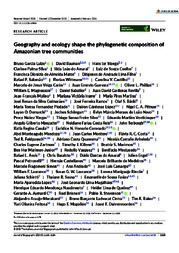Publications
Geography and ecology shape the phylogenetic composition of Amazonian tree communities.
Author(s): LUIZE, B. G.; BAUMAN, D.; STEEGE, H. ter; PALMA-SILVA, C.; AMARAL, I. L. do; COELHO, L. de S.; MATOS, F. D. de A.; LIMA FILHO, D. de A.; SALOMÃO, R. P.; WITTMANN, F.; CASTILHO, C. V.; CARIM, M. de J. V.; GUEVARA, J. E.; PHILLIPS, O. L.; MAGNUSSON, W. E.; SABATIER, D.; REVILLA, J. D. C.; MOLINO, J.-F.; IRUME, M. V.; MARTINS, M. P.; GUIMARÃES, J. R. da S.; RAMOS, J. F.; BÁNKI, O. S.; PIEDADE, M. T. F.; LÓPEZ, D. C.; PITMAN, N. C. A.; DEMARCHI, L. O.; SCHÖNGART, J.; NOVO, E. M. M. de L.; VARGAS, P. N.; SILVA, T. S. F.; VENTICINQUE, E. M.; MANZATTO, A. G.; REIS, N. F. C.; TERBORGH, J.; CASULA, K. R.; CORONADO, E. N. H.; MENDOZA, A. M.; MONTERO, J. C.; COSTA, F. R. C.; FELDPAUSCH, T. R.; QUARESMA, A. C.; ARBOLEDA, N. C.; ZARTMAN, C. E.; KILLEEN, T. J.; MARIMON, B. S.; MARIMON-JUNIOR, B. H.; VASQUEZ, R.; MOSTACEDO, B.; ASSIS, R. L.; BARALOTO, C.; AMARAL, D. D. do; ENGEL, J.; PETRONELLI, P.; CASTELLANOS, H.; MEDEIROS, M. B. de; SIMON, M. F.; ANDRADE, A.; CAMARGO, J. L.; LAURANCE, W. F.; LAURANCE, S. G. W.; RINCÓN, L. M.; SCHIETTI, J.; SOUSA, T. R.; FARIAS, E. de S.; LOPES, M. A.; MAGALHÃES, J. L. L.; NASCIMENTO, H. E. M.; QUEIROZ, H. L. de; AYMARD C, G. A.; BRIENEN, R.; STEVENSON, P. R.; ARAUJO-MURAKAMI, A.; CINTRA, B. B. L.; BAKER, T. R.; FEITOSA, Y. O.; MOGOLLÓN, H. F.; DUIVENVOORDEN, J. F.; PERES, C. A.; SILMAN, M. R.; FERREIRA, L. V.; LOZADA, J. R.; COMISKEY, J. A.; TOLEDO, J. J. de; DAMASCO, G.; DÁVILA, N.; DRAPER, F. C.; GARCÍA-VILLACORTA, R.; LOPES, A.; VICENTINI, A.; VALVERD, F. C.; ALONSO, A.; ARROYO, L.; DALLMEIER, F.; GOMES, V. H. F.; JIMENEZ, E. M.; NEILL, D.; MORA, M. C. P.; NORONHA, J. C.; AGUIAR, D. P. P. de; BARBOSA, F. R.; BREDIN, Y. K.; CARPANEDO, R. de S.; CARVALHO, F. A.; SOUZA, F. C. de; FEELEY, K. J.; GRIBEL, R.; HAUGAASEN, T.; HAWES, J. E.; PANSONATO, M. P.; PAREDES, M. R.; RODRIGUES, D. de J.; BARLOW, J.; BERENGUER, E.; SILVA, I. B. da; FERREIRA, M. J.; FERREIRA, J. N.; FINE, P. V. A.; GUEDES, M. C.; LEVIS, C.; LICONA, J. C.; ZEGARRA, B. E. V.; VOS, V. A.; CERÓN, C.; DURGANTE, F. M.; FONTY, E.; HENKEL, T. W.; HOUSEHOLDER, J. T.; HUAMANTUPA-CHUQUIMACO, I.; SILVEIRA, M.; STROPP, J.; THOMAS, R.; DALY, D.; MILLIKE, W.; MOLINA, G. P.; PENNINGTON, T.; VIEIRA, I. C. G.; ALBUQUERQUE, B. W.; CAMPELO, W.; FUENTES, A.; KLITGAARD, B.; PENA, J. L. M.; TELLO, J. S.; VRIESENDORP, C.; CHAVE, J.; FIORE, A. D.; HILÁRIO, R. R.; PEREIRA, L. de O.; PHILLIPS, J. F.; RIVAS-TORRES, G.; ANDEL, T. R. van; HILDEBRAND, P. von; BALEE, W.; BARBOSA, E. M.; BONATES, L. C. de M.; DOZA, H. P. D.; GÓMEZ, R. Z.; GONZALES, T.; GONZALES, G. P. G.; HOFFMAN, B.; JUNQUEIRA, A. B.; MALHI, Y.; MIRANDA, I. P. de A.; PINTO, L. F. M.; PRIETO, A.; RUDAS, A.; RUSCHEL, A. R.; SILVA, N.; VELA, C. I. A.; ZENT, S.; ZENT, E. L.; CANO, A.; MÁRQUEZ, Y. A. C.; CORREA, D. F.; COSTA, J. B. P.; FLORES, B. M.; GALBRAITH, D.; HOLMGREN, M.; KALAMANDEEN, M.; LOBO, G.; MONTENEGRO, L. T.; NASCIMENTO, M. T.; OLIVEIRA, A. A.; POMBO, M. M.; RAMIREZ-ANGULO, H.; ROCHA, M.; SCUDELLER, V. V.; UMAÑA, M. N.; HEIJDEN, G. van der; TORRE, E. V.; REATEGUI, M. A. A.; BAIDER, C.; BALSLEV, H.; CÁRDENAS, S.; CASAS, L. F.; FARFAN-RIOS, W.; FERREIRA, C.; LINARES-PALOMINO, R.; MENDOZA, C.; MESONES, I.; PARADA, G. A.; TORRES-LEZAMA, A.; GIRALDO, L. E. U.; VILLARROEL, D.; ZAGT, R.; ALEXIADES, M. N.; OLIVEIRA, E. A. de; GARCIA-CABRERA, K.; HERNANDEZ, L.; CUENCA, W. P.; PANSINI, S.; PAULETTO, D.; AREVALO, F. R.; SAMPAIO, A. F.; SANDOVAL, E. H. V.; GAMARRA, L. V.; DEXTER, K. G.
Summary: Aim Amazonia hosts more tree species from numerous evolutionary lineages, both young and ancient, than any other biogeographic region. Previous studies have shown that tree lineages colonized multiple edaphic environments and dispersed widely across Amazonia, leading to a hypothesis, which we test, that lineages should not be strongly associated with either geographic regions or edaphic forest types. Location Amazonia. Taxon Angiosperms (Magnoliids; Monocots; Eudicots). Methods Data for the abundance of 5082 tree species in 1989 plots were combined with a mega-phylogeny. We applied evolutionary ordination to assess how phylogenetic composition varies across Amazonia. We used variation partitioning and Moran's eigenvector maps (MEM) to test and quantify the separate and joint contributions of spatial and environmental variables to explain the phylogenetic composition of plots. We tested the indicator value of lineages for geographic regions and edaphic forest types and mapped associations onto the phylogeny. Results In the terra firme and várzea forest types, the phylogenetic composition varies by geographic region, but the igapó and white-sand forest types retain a unique evolutionary signature regardless of region. Overall, we find that soil chemistry, climate and topography explain 24% of the variation in phylogenetic composition, with 79% of that variation being spatially structured (R2?=?19% overall for combined spatial/environmental effects). The phylogenetic composition also shows substantial spatial patterns not related to the environmental variables we quantified (R2?=?28%). A greater number of lineages were significant indicators of geographic regions than forest types. Main Conclusion Numerous tree lineages, including some ancient ones (>66?Ma), show strong associations with geographic regions and edaphic forest types of Amazonia. This shows that specialization in specific edaphic environments has played a long-standing role in the evolutionary assembly of Amazonian forests. Furthermore, many lineages, even those that have dispersed across Amazonia, dominate within a specific region, likely because of phylogenetically conserved niches for environmental conditions that are prevalent within regions.
Publication year: 2024
Types of publication: Journal article

